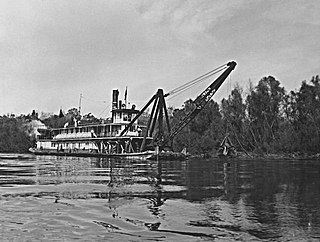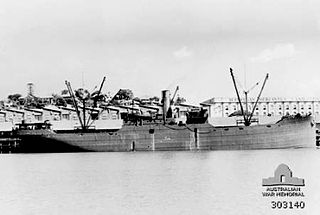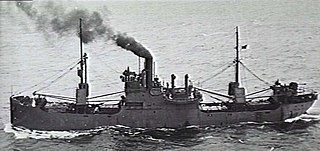
A steamship, often referred to as a steamer, is a type of steam-powered vessel, typically ocean-faring and seaworthy, that is propelled by one or more steam engines that typically move (turn) propellers or paddlewheels. The first steamships came into practical usage during the early 1800s; however, there were exceptions that came before. Steamships usually use the prefix designations of "PS" for paddle steamer or "SS" for screw steamer. As paddle steamers became less common, "SS" is assumed by many to stand for "steamship". Ships powered by internal combustion engines use a prefix such as "MV" for motor vessel, so it is not correct to use "SS" for most modern vessels.

A steamboat is a boat that is propelled primarily by steam power, typically driving propellers or paddlewheels. Steamboats sometimes use the prefix designation SS, S.S. or S/S or PS ; however, these designations are most often used for steamships.

USS Oglala (ID-1255/CM-4/ARG-1) was a minelayer in the United States Navy. Commissioned as Massachusetts, she was renamed Shawmut a month later, and in 1928, was renamed after the Oglala, a sub-tribe of the Lakota, residing in the Black Hills of South Dakota.

W. T. Preston is a specialized sternwheeler that operated as a snagboat, removing log jams and natural debris that prevented river navigation on several Puget Sound-area rivers. She is now the centerpiece of the Snagboat Heritage Center in Anacortes, Washington. She was designated a National Historic Landmark in 1989. Built in 1929, she is one of two surviving snagboats built and operated by the United States Army Corps of Engineers, and the only one on the American west coast.

Estrella was a paddle steamship built by Samuda Brothers in London in 1853 for the Magdalena Steam Navigation Company's commercial services in present-day Colombia. In 1862 she was sold to United States owners and briefly used as a Union Army transport before being acquired by the Union Navy. She served as the armed steamship USS Estrella during the remainder of the American Civil War, carrying three heavy guns as well as two howitzers for shore bombardment.

Montgomery is a steam-powered sternwheel-propelled snagboat built in 1925 by the Charleston Dry Dock and Machine Company of Charleston, South Carolina, and operated by the United States Army Corps of Engineers. Montgomery cleared snags and obstructions from the Coosa, Alabama, Apalachicola, Chattahoochee, Flint, Black Warrior, and Tombigbee Rivers until her retirement from the Corps of Engineers on November 8, 1982. She was restored in 1984 and again in 2004. One of only two surviving Army Corps of Engineers snagboats, she was declared a National Historic Landmark in 1989. Montgomery now operates as a museum ship at the Tom Bevill Lock and Dam Visitor Center in Pickensville, Alabama.

Many steamboats operated on the Columbia River and its tributaries, in the Pacific Northwest region of North America, from about 1850 to 1981. Major tributaries of the Columbia that formed steamboat routes included the Willamette and Snake rivers. Navigation was impractical between the Snake River and the Canada–US border, due to several rapids, but steamboats also operated along the Wenatchee Reach of the Columbia, in northern Washington, and on the Arrow Lakes of southern British Columbia.

A snagboat is a river boat, resembling a barge with superstructure for crew accommodations, and deck-mounted cranes and hoists for removing snags and other obstructions from rivers and other shallow waterways.

New Orleans was the first steamboat on the western waters of the United States. Owned by Robert Fulton and Robert R. Livingston, and built by Nicholas Roosevelt, its 1811–1812 voyage from Pittsburgh, Pennsylvania, to New Orleans, Louisiana, on the Ohio and Mississippi rivers ushered in the era of commercial steamboat navigation on the western and mid-western continental rivers.

Sue H. Elmore was a steamboat built for service on the coast of Oregon and southwest Washington. From 1900 to 1917, the vessel's principal route ran from Portland, Oregon down the Columbia River to Astoria, and then west across the Columbia Bar, then south along the Oregon coast to Tillamook Bay. Once at Tillamook Bay, Sue H. Elmore was one of the few vessels that could reach Tillamook City at the extreme southern edge of the mostly very shallow bay. After this Sue H. Elmore was sold, being operated briefly in Puget Sound under the name Bergen, and then for many years, out of San Diego, California as a tugboat under the name Cuyamaca. During World War II Cuyamaca was acquired by the U.S. Army which operated the vessel as ST-361. Afterwards the army sold ST-361 and the vessel returned to civilian ownership, again under the name Cuyamaca. In 1948 Cuyamaca sank in a harbor in Venezuela, but was raised and by the early 1950s, was owned by one A. W. Smith, of Pensacola, Florida. This vessel's former landing place in Tillamook, Oregon is now a municipal park named after the ship.
Steamboats operated in California on San Francisco Bay and the Sacramento–San Joaquin River Delta, and Sacramento River as early as November 1847, when the Sitka built by William A. Leidesdorff briefly ran on San Francisco Bay and up the Sacramento River to New Helvetia. After the first discovery of gold in California the first shipping on the bays and up the rivers were by ocean going craft that were able to sail close to the wind and of a shallow enough draft to be able to sail up the river channels and sloughs, although they were often abandoned by their crews upon reaching their destination. Regular service up the rivers, was provided primarily by schooners and launches to Sacramento and Stockton, that would take a week or more to make the trip.

Elwood was a sternwheel steamboat which was built to operate on the Willamette River, in Oregon, but which later operated on the Lewis River in Washington, the Stikine River in Canada, and on Puget Sound. The name of this vessel is sometimes seen spelled "Ellwood". Elwood is probably best known for an incident in 1893, when it was approaching the Madison Street Bridge over the Willamette River in Portland, Oregon. The bridge swung open to allow the steamer to pass. However, a streetcar coming in from the east end of the bridge failed to notice the bridge was open, and ran off into the river in the Madison Street Bridge disaster.

Orient was a light-draft sternwheel-driven steamboat built in 1875 for the Willamette River Transportation Company, a concern owned by pioneer businessman Ben Holladay. Shortly after its completion, it was acquired by the Oregon Steam Navigation Company. Orient was a near-twin vessel of a steamer built at the same time, the Occident.

SS Cynthia Olson was a cargo ship originally built in Wisconsin in 1918 as the SS Coquina. Renamed in 1940, in August 1941 she was chartered by the US Army to transport supplies to Hawaii. While in passage between Tacoma, Washington and Honolulu on December 7, she was intercepted by the Japanese submarine I-26, which sank her with gunfire. Although the commander of the submarine ensured that all of the crew had escaped into boats, none of them were ever found. Cynthia Olson was the first United States Merchant Marine vessel to be sunk after the entry of the United States into World War II.

SS Managua was a Nicaraguan cargo ship that the German submarine U-67 torpedoed on 16 June 1942 in the Straits of Florida while she was travelling from Charleston, South Carolina, United States to Havana, Cuba with a cargo of potash. The ship was built as Glorieta, a Design 1049 ship in 1919, operated by the United States Shipping Board (USSB) until sold to the Munson Steamship Line in 1920 and renamed Munisla. The ship was sold foreign to a Honduran company, Garcia, in 1937 and renamed Neptuno. In 1941 the ship was re-flagged in Nicaragua with the name Managua.

SS Coast Trader was built as the cargo ship SS Holyoke Bridge in 1920 by the Submarine Boat Company in Newark, New Jersey. The Coast Trader was torpedoed and sank 35 miles (56 km) south west of Cape Flattery, off the Strait of Juan de Fuca in U.S. state of Washington by the Japanese submarine I-26. Survivors were rescued by schooner Virginia I and HMCS Edmundston. She rests on the ocean floor at.

SS Lake Elsmere was an Emergency Fleet Corporation (EFC) Design 1074 cargo ship built for the United States Shipping Board (USSB) during the massive shipbuilding effort of World War I.
Yuba was a wooden-hulled, stern-wheel steamship that served as a snagboat for the United States Army Corps of Engineers.
A. W. de Young Boat & Shipbuilding Company was a shipbuilder located in Alameda, California active in the 1920s. She was incorporated in 1924 with $150,000 in share capital by ship designer and builder A. W. de Young in partnership with R.J. Connor. De Young had previously operated a ship repair facility on the Oakland side of the estuary but due to high business demand needed to acquire more space. The yard was located at the foot of Chestnut Street. The firm immediately secured contracts to build ten 75-foot patrol boats for the United States Coast Guard at $21,637 apiece which were all completed and in commission by 1925; a pile driver for the San Francisco Harbor Board; a snagboat (Yuba) for the U.S. Engineers Department of the Army for use on the Sacramento River completed in 1924; as well as improvements to the Dollar Steamship Company's dock facilities. She went on to build a variety of ships thereafter mostly focusing on barges, dredges, and freighters for local use including a twin-screw, shallow-draft, bay freighter for the South Shore Port Company.

Bear was a wooden-hulled, stern-wheel steamship that served as a snagboat for the United States Army Corps of Engineers.















